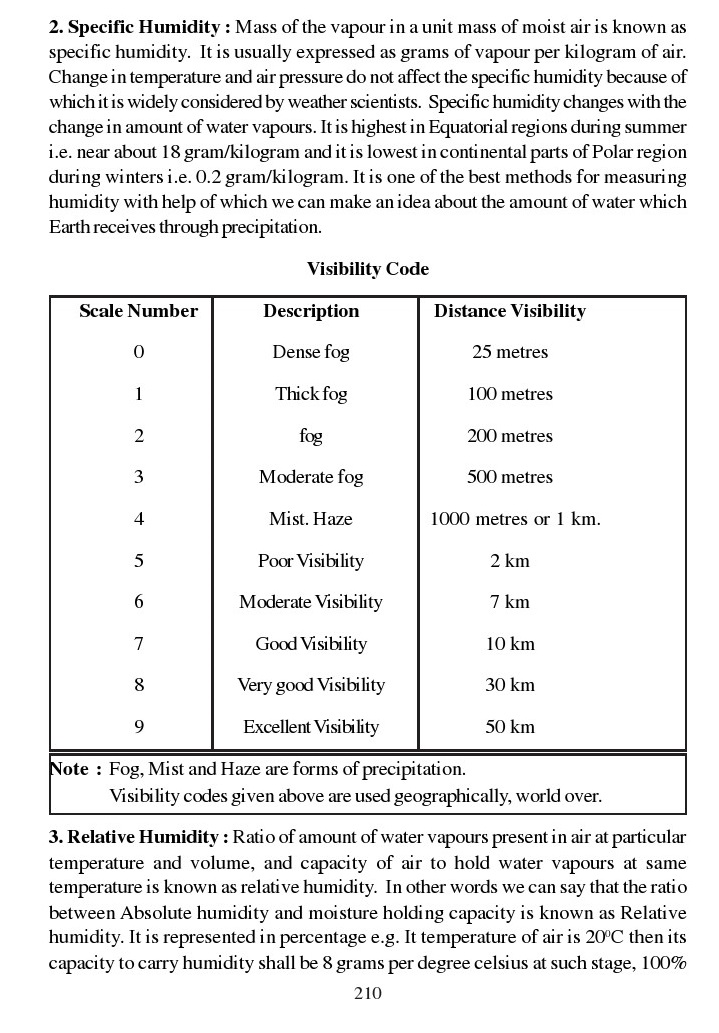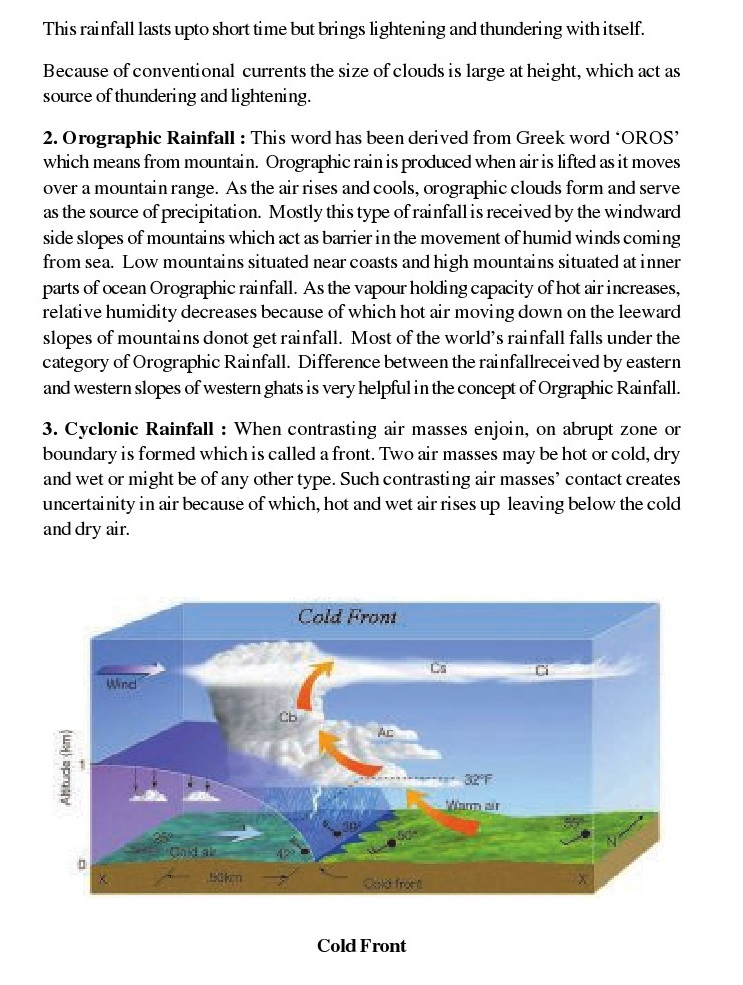CHAPTER NO.8 HUMIDITY AND PRECIPITATION
CHAPTER NO.8 HUMIDITY AND PRECIPIATION
Water is present in air in gaseous state like other
gases while it enters into atmosphere from various water sources in the form of
vapours because of evaporation which takes place because of the heat of Sun.
Amount of water vapours in atmosphere varies with
time and place. Itis measured in comparison to volume on the scale from 0 to 4
percent but even small amount of variation is very important from the aspect of
weather. Gaseous form of water present in airis known as humidity. Humidity is
directly related with temperature and its amount
decreases as we move from Equator to Poles and
moreover it also decreases with increase of height.
From the aspect of weather science humidty is
measured and represented in various ways. Details about these are given below:
1. Absolute humidity : Absolute humidity is the
actual amount of water vapour
present in a given volume of air. Itis represented
in gram per cubic meter unit. This method is not commonly used by weather
scientists because absolute humidity changes with the change in volume due to
expansion and shrinking of air although the humidity in air may not change.
Amount of absolute humidity decreases as we move from Equator to Poles and
oceans to continents. Absolute humidity gives us information about the
precipitation on a particular place.
2. Specific Humidity : Mass of the vapour in a unit
mass of moist air is known as specific humidity. [tis usually expressed as
grams of vapour per kilogram of air.Change in temperature and air pressure do
not affect the specific humidity because of
which it is widely considered by weather scientists.
Specific humidity changes with the change in amount of water vapours. Itis
highest in Equatorial regions during summer i.e. near about 18 gram/kilogram
and it is lowest in continental parts of Polar region
during winters i.e. 0.2 gram/kilogram. It is one of
the best methods for measuring humidity with help of which we can make an idea
about the amount of water which Earth receives through precipitation.
3. Relative Humidity : Ratio of amount of water
vapours present in air at particular temperature and volume, and capacity of
air to hold water vapours at same temperature is known as relative humidity. In
other words we can say that the ratio between Absolute humidity and moisture
holding capacity is known as Relative humidity. It is represented in percentage
e.g. It temperature of air is 20°C then its capacity to carry humidity shall be
8 grams per degree celsius at such stage, 100% relative humidity means, air is
completely saturated. It means that relat've humidity is
full to its capacity. This situation arises in
following circumstances :—
(i) When absoulte humidity increases due to high
evaporation.
(ii) When moisture holding capacity of air decreases
due to low temperature.
Relative humidity decreases when the temperature of
air increases. Relative humidity is very important for scientists working on
atmosphere because information about precipitation is possible through various
forms of humidity. In human life relative
humidity and comfort are related e.g. People donot
like to live in regions having high relative humidity (i.e. more than 60 percent)Rainfall
as agent of Precipitation
Water from our mother earth enters into atmosphere
through evaporation and in the form of water vapours. These vapours move from
one place to other with the help of winds. Water vapours get converted into
solid or liquid state by condensation and they fall on Earth. This process is
known as condensation. Precipitation takes place in various forms at different
places of world. Its most important form is ‘Rainfall’.
Technically when condensation takes place at temperature
above zero degree celcius then water vapours convert into water drops. Their
size varies upto 10 micrometer (size of human hair is 75 micrometer) A droplet
of rain water is of more than SOO microne and clouds are formed by lakhs of
such drops. Hot and humid air and humidity holding centers are required in
large amounts to form condition for Rainfall. Water
vapours get collected around these centers and
clouds are formed when hot and humid air rises up and after cooling relative
humidity comes to 100 percent. Formation of clouds does not necessarily mean
that there will be rainfall because the size of drops of clouds is very small
and their buoyancy in atmosphere does not allow them to fall as rain on Earth.
Size of water drops suspended in air increases when they strike with
each other. When their increasing size breaks the
holding capacity of air, they fall as rain on Earth.
1 micrometer = 10,00,000th part of 1 meter
Types of Rainfall
Rainall is caused by clouds while formation of
clouds 1s due to condensation and saturation. Rainfall may be divided into
three types on the basis of upward movement of air :-
1. Convectional Rainfall : C onvectional rainfall is
caused by convection, where the surface layer of atmosphere is heated by the
heat of sun causing the moisture laden air torise. As the air rises it cools
down to form clouds by the process of condensation which results in rainfall.
Rate of decrease in temperature which is known as adiabotic
lapse rate 1s 10°C per 1000 meter, causing
condensation which further helps in formation of nimbus clouds. This type of
rainfall occurs daily at the lower latitudes.Generally day time heating creates
convection and by the afternoon, convectional winds get saturated.
On the other hand at higher lattitudes this type of
rainfall occurs during summer season.
This rainfall lasts upto short time but brings
lightening and thundering with itself.Because of conventional currents the size
of clouds is large at height, which act as source of thundering and lightening.
2. Orographic Rainfall : This word has been derived
from Greek word “OROS’
which means from mountain. Orographic rain is
produced when air is lifted as it moves over a mountain range. As the air rises
and cools, orographic clouds form and serve as the source of precipitation.
Mostly this type of rainfall 1s received by the windward
side slopes of mountains which act as barrier in the
movement of humid winds coming from sea. Low mountains situated near coasts and
high mountains situated at inner parts of ocean Orographic rainfall. As the
vapour holding capacity of hot air increases,relative humidity decreases
because of which hot air moving down on the leeward slopes of mountains donot
get rainfall. Most of the world’s rainfall falls under the
category of Orographic Rainfall. Difference between
the rainfallreceived by eastern and western slopes of western ghats is very
helpful in the concept of Orgraphic Rainfall.
3. Cyclonic Rainfall : When contrasting air masses
enjoin, on abrupt zone or
boundary is formed which 1s called a front. Two air
masses may be hot or cold, dry and wet or might be of any other type. Such
contrasting air masses” contact creates uncertai nity in air because of which,
hot and wet air rises up leaving below the cold and dry air.
This type of rainfall may further be divided into
two types. Tropical regions receive cyclonic rainfall when humid air having
different temperatures conjugate. Hot humid air starts rising resulting in
formation of clouds which further leads to rainfall. In temperate regions, when
hot and cold air masses make contact, an abrupt zone is formed. In this zone
the hot air over rides the cold air resulting in the formation of cyclone.
During Winters Punjab and North Western parts of India receive rainfall through
cyclones arising from Gulf of Persia.
Distribution of Rainfall ; Distribution of rainfall
is very complex in the world. Rainfall on a particular place depends on
lattitude, humidity, winds, relief, atmospheric conditions etc. Because of all
these there are spatial and temporal variations in the division of rainfall.
Average rainfall on earth is 80 centimeter but large variations are found in
this.
Equatorial regions receive (1000.cm) rainfall
continuously throughtout the year. On the other hand tropical Desert regions
remain dry throughtout the year and they receive rainfall upto 10cm only. In
South American nation chile, Behia Faliksh region receives rian for 325 days
each year while Erika region of Chile does not receive any rain
continuously for years. Monsoon regions like India
receive 80 percent of their annual rainfall during four months i.e. June to
Septemeber.
Rainfall pattern of the world may be
divided into six major regions :—
1. High rainfall Equatorial region : Region between
10° N and 10° S lattitudes is known as Intertropical convergence. This region
receives vertical sun rays because of which condensation of hot and humid air
results in heavy rainfall continously throughout the year touching average of
150 to 200 cm annually
2. Trade wind region : Eastern parts of continents
receive rainfall from the humid winds coming from sea because of the perennial
winds blowing between 10° to 20°lattitudes in both the spheres. These winds
become dry while reaching on the western parts of the continents because of
this these parts donot receive any rainfall. That is why
deserts are situated on the western parts of
continents. Basically, Trade wind region receives rainfall during summer
season.
3. Sub Tropical Scanty rainfall region : High
pressure regions are located (situated)between 20° to 30° lattitudes in both
the spheres. In these regions air moves down due to anti cyclones because of
which favourable conditions are not created for rainfall and these regions
remain dry.
4. Mediterraneon regions : Regions situated between
30° to 40° lattitudes in both the spheres receive rainfall in winters from
westerlies and they remian dry during summer under the effect of (eastern)
trade winds.
5. Mid Latitudnal high rainfall regions : Western
parts of continents situated
between 40° to 50’ latitudes in both the spheres
receive heavy rainfall under the effect of westerlies blowing from sea to land
however aAmount of rainfall decreases as winds proceed to eastern parts.
6. Low rainfall polar regions : Amount of rainfall
decreases in the regions situated above 60° latitude in both the spheres
because of low temperature and high air pressure. These regions receive average
rainfall of 25 centimeters annually.
EXERCISE
1. Answer the following
{a) What name is given to ‘Specific Humidity’ in
Punjabi?
(b) If a place faces high evaporation, what type of
humidity shell
increase?
(c) What is liquid form of Humidity?
(d) At what name 'Hail'is known as gaseous form
prior to solidifying?
(e) What is cyclonic rainfall known in Punjabi?
2 Answer the followings in 60 to 80
words.
(a) What is humidity? Name various types of
humidity.
(b) What is rainfall? name various types of
rainfall?
(c) What is the difference between precipitation and
rainfall? Explain..
(d) What is Saturated air ? Explain.
(e) What relation humidity, winid and temperature
have ? Write short note.
3. Answer the following in 150 to 200
words :
(a) Give detailed account of various types of
humidity.
(b) Give detailed account of various types of
rainfall.
(c) Explain distribution of rainfall, worldover.














